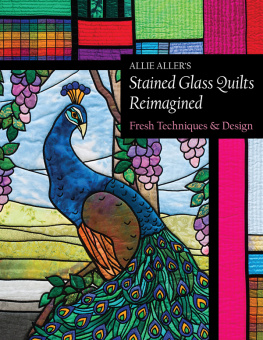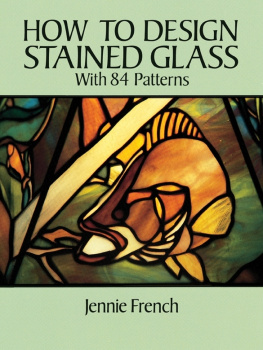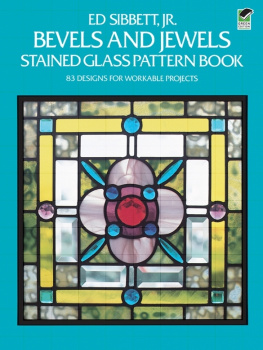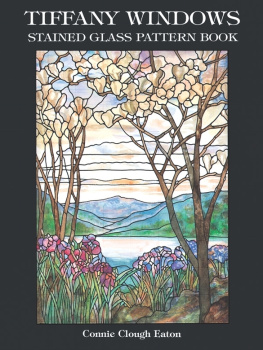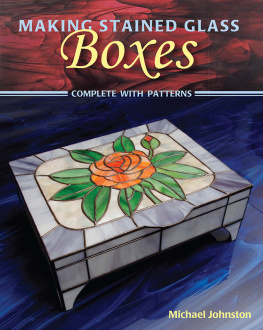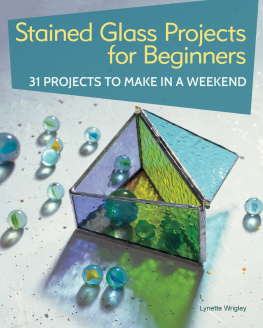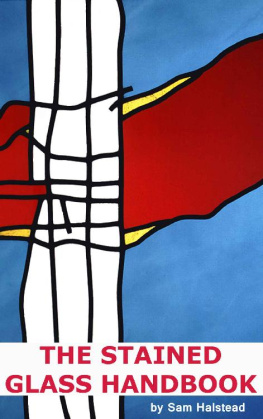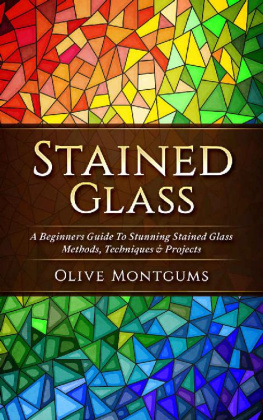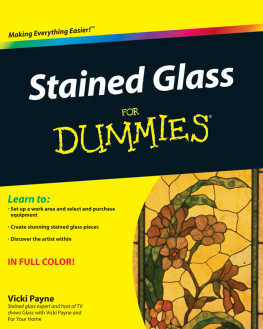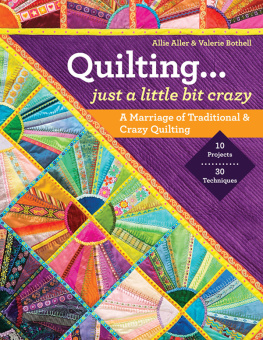Publisher: Amy Marson
Creative Director: Gailen Runge
Editors: Liz Aneloski and Donna di Natale
Technical Editors: Susan Nelsen and Amanda Siegfried
Cover/Book Designer: April Mostek
Production Coordinators: Tim Manibusan and Joe Edge
Production Editor: Alice Mace Nakanishi
Illustrator: Valyrie Gillum
Photo Assistant: Carly Jean Marin
Photography by Diane Pedersen of C&T Publishing, unless otherwise noted
Published by C&T Publishing, Inc., P.O. Box 1456, Lafayette, CA 94549
Dedication
For my boyfriend, best friend, and husband, Robert, who truly is the man of my dreams.

Man of My Dreams, 16 18, 2015
Acknowledgments
There are three great artists whose work has inspired my love affair with stained glass quilts: Louis Comfort Tiffany, Maxfield Parrish, and Frank Lloyd Wright. Their sense of color and design has fed my soul for decades and first prompted my foray into this quiltmaking genre 25 years ago.
I have many people in the here and now to thank as well, starting with Tess Hall Neri, Dale Kastle, Mary Corbet, Holly Casey, and Patty Young for their contributions to this book. Thanks go to Georgia Granato of the incomparable Fabric Depot in Portland, Oregon, and to my friend Lisa Plooster Boni, for being my sounding boards. Those listed in the Favorite Supplies section generously contributed their quality products to the making of my quilts, and I sincerely thank them. I feel great gratitude to Gailen Runge, the creative director of C&T Publishing, for letting me run with this project; to Liz Aneloski, my editor, for helping me mold it into shape; and to Susan Nelsen, my technical editor, who surefootedly led me out of some sticky thickets.
Here at home, all love to my husband, Robert, for his unwavering support and his valuable input not to mention his homemade pizza with that killer homegrown sauce.

Back in the 1990s, I spent several years developing my own techniques for making stained glass quiltsand I made a lot of them. Then crazy quilting burst into my life, and sixteen joyous years of hand stitching flew by. But recently, in the mysterious ways of the muse, I was drawn back again to my earlier stained glass work, wanting to discover more.

The Attendant, 60 66, 1997
Photo by Bill Bachhuber
When I think about it, there were three main reasons for my change in direction. The first was the graphic nature of stained glass quilts. Composition, color, line, shape, and fabric choice are all paramount; texture is secondary, embellishment just about nonexistent. This was a refreshing change and challenge to me as a designer. My attraction to stripped-down design was also no doubt influenced by the Modern Quilt movement going on all around me.
Another reason for renewing my work in stained glass quilting is how quickly these quilts come together. While some are intricate and require patience, once you are familiar with the processes in this book you will see that these quilts can be completed relatively quickly. We get to work with lots of new fabrics and projects this way!
Finally, the challenge of pushing the envelope in this quilt genre to make it new again was irresistible. I have poured everything I have learned and loved into this book in the hopes that you can explore your own ideas and take your own stained glass quilts further, too. There is no bias tape to be found on these pages, and you can adapt the approaches presented here to any style of quilting that you love.
Chapter One examines how to source, develop, and work with your own designs. Which supplies and construction methods to use with these new approaches to stained glass quilting are covered in Chapter Two. Chapter Three has the nitty-gritty step-by-step information on the three main techniques Ive used throughout the bookcouching, appliqud ribbon and trim, and iron-on leadingas well as some introductory exercises. The gallery showcases these techniques in action, and the six projects will help you to practice them yourself. Three full-sized pullout patterns enable you to dive right in. Two of them are simple; the other will keep you busy for a while. Four of the projects are functional quilts and two are decorative, with many variations presented.
So, welcome! Im delighted that you are here.
Allie

The stained glass quilts presented in this book are both functional quilts and decorative wallhangings. While the functional quilts use block patterns or overall piecing layouts, the wallhangings generally require a pattern design. But where do you look for inspiration and how do you make your own pattern? This is the focus of this chapter.
Many areas of design can lend themselves to stained glass quilt work. Indeed, if you think of stained glass quilting as outlined art, any design based on simple line drawings or shapes can be transformed into a pattern.
First we will look at the plethora of design resources available to us today. Next we will talk about options for enlarging your design of choice to the size quilt you wish to make. After that, I share different methods for transferring those designs to fabric. Finally, I will give you a start-to-finish example of creating a little quilt from a homemade pattern to illustrate these ideas.
Pattern Ideas Are Everywhere
When I first explored stained glass quilting many years ago, I quickly discovered that appliqu patterns lend themselves to the outline technique used for stained glass quilts. And what a wealth of design inspiration there is in the appliqu world, to be sure!

Stained Glass Poppies, 32 32
An interpretation of the cover quilt of Nancy Pearsons Floral Appliqu: Original Designs and Techniques for Medallion Quilts (EZ Quilting by Wrights, 2000)
Page through your collection of appliqu books and see what intrigues you as a possible stained glass design. With the techniques we will cover in this book you will be able to create a pattern from what you like and then make it. (Of course, all copyright laws apply; you may create patterns for your personal use from publications and designers work, but you may not profit from them. This does not apply to vintage designs that are out of copyright.)
Needlework and Vintage Designs
Blackwork is a needlework technique that requires charted geometric line drawings. These designs can be easily adapted for our use. If you do an Internet image search on the term blackwork, you will be amazed at what comes up. This is a great source of inspiration and design.

Blackwork designs by Mary Corbet
Do you love those old embroidery transfers from the 1930s? What whimsical stained glass projects could grow from those! These designs can be found on eBay and at local estate sales, or they may already be waiting for you in a drawer at home.
Next page
